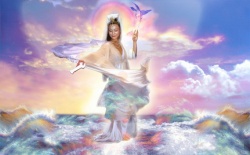Akanitthā devā
A class of devas, living in the highest of the five Suddhāvasā (Pure Mansions) (D.iii.237).
In the Mahāpadāna Sutta (D.ii.52f) The Buddha mentions that he visited their abode and conversed with beings who were born there as a result of the holy lives they had lived under various Buddhas.
In the Sakkapañha Sutta (D.ii.286) Sakka speaks of them as the highest devas, and expresses his satisfaction that he, too, will be born among them in his last Life.
Buddhaghosa says they are so called because of their supremacy in Virtue and in Happiness, and because there are no juniors among them (sabbeh'eva sagunehi ca bhavasampattiyā ca jetthā n'atth'ettha kanitthāti akanitthā). DA.ii.480. VbhA.521 [āyunā ca paññaya ca Akanitthā jetthakā sabba-devehi panītatarā devā (=DA.iii.739)].
In the Visuddhi Magga (p. 634) their World is spoken of as a Brahma Loka where Anāgāmīs are born and enter complete Nibbāna (p. 710) (also ItA.40; DA.iii.740). The duration of Life among these devas is 16,000 Kalpas (Kvu.207). Sometimes Anāgāmī are born among the Avihā devas and finish their existence, in a subsequent birth, among the Akanitthās. These are called "Uddhamsotā." (DhA.iii.289f.; see also S.v.201).
The Akanittha-Bhavana is the upper limit of the rūpvacara-Bhūmi (Ps.i.84); it is also spoken of as the highest point of the Universe, Avīci being the lowest. Thus the quarrel among the Kosambī Monks spread even up to the Akanitthā devā (J.iii.487), as did the shouts of the assembly at the severing of the branch of the Bodhi tree (Mbv. 150-1; see also Mil. 284).
